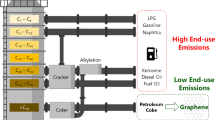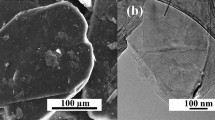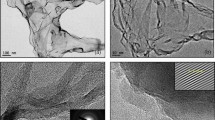Abstract
Most bulk-scale graphene is produced by a top-down approach, exfoliating graphite, which often requires large amounts of solvent with high-energy mixing, shearing, sonication or electrochemical treatment1,2,3. Although chemical oxidation of graphite to graphene oxide promotes exfoliation, it requires harsh oxidants and leaves the graphene with a defective perforated structure after the subsequent reduction step3,4. Bottom-up synthesis of high-quality graphene is often restricted to ultrasmall amounts if performed by chemical vapour deposition or advanced synthetic organic methods, or it provides a defect-ridden structure if carried out in bulk solution4,5,6. Here we show that flash Joule heating of inexpensive carbon sources—such as coal, petroleum coke, biochar, carbon black, discarded food, rubber tyres and mixed plastic waste—can afford gram-scale quantities of graphene in less than one second. The product, named flash graphene (FG) after the process used to produce it, shows turbostratic arrangement (that is, little order) between the stacked graphene layers. FG synthesis uses no furnace and no solvents or reactive gases. Yields depend on the carbon content of the source; when using a high-carbon source, such as carbon black, anthracitic coal or calcined coke, yields can range from 80 to 90 per cent with carbon purity greater than 99 per cent. No purification steps are necessary. Raman spectroscopy analysis shows a low-intensity or absent D band for FG, indicating that FG has among the lowest defect concentrations reported so far for graphene, and confirms the turbostratic stacking of FG, which is clearly distinguished from turbostratic graphite. The disordered orientation of FG layers facilitates its rapid exfoliation upon mixing during composite formation. The electric energy cost for FG synthesis is only about 7.2 kilojoules per gram, which could render FG suitable for use in bulk composites of plastic, metals, plywood, concrete and other building materials.
This is a preview of subscription content, access via your institution
Access options
Access Nature and 54 other Nature Portfolio journals
Get Nature+, our best-value online-access subscription
$29.99 / 30 days
cancel any time
Subscribe to this journal
Receive 51 print issues and online access
$199.00 per year
only $3.90 per issue
Buy this article
- Purchase on Springer Link
- Instant access to full article PDF
Prices may be subject to local taxes which are calculated during checkout




Similar content being viewed by others
Data availability
The datasets generated and/or analysed during the current study are available from the corresponding author on reasonable request.
References
Allen, M. J., Tung, V. C. & Kaner, R. B. Honeycomb carbon: a review of graphene. Chem. Rev. 110, 132–145 (2010).
Yi, M. & Shen, Z. A review on mechanical exfoliation for the scalable production of graphene. J. Mater. Chem. A 3, 11700–11715 (2015).
Hernandez, Y. et al. High-yield production of graphene by liquid-phase exfoliation of graphite. Nat. Nanotechnol. 3, 563–568 (2008).
Eda, G., Fanchini, G. & Chhowalla, M. Large-area ultrathin films of reduced graphene oxide as a transparent and flexible electronic material. Nat. Nanotechnol. 3, 270–274 (2008).
Li, D. et al. Processable aqueous dispersions of graphene nanosheets. Nat. Nanotechnol. 3, 101–105 (2008).
Lin, L., Peng, H. & Liu, Z. Synthesis challenges for graphene industry. Nat. Mater. 18, 520–524 (2019).
Ferrari, A. C. et al. Raman spectrum of graphene and graphene layers. Phys. Rev. Lett. 97, 187401 (2006).
Ferrari, A. C. Raman spectroscopy of graphene and graphite: disorder, electron–phonon coupling, doping and nonadiabatic effects. Solid State Commun. 143, 47–57 (2007).
Malard, L. M., Pimenta, M. A., Dresselhaus, G. & Dresselhaus, M. S. Raman spectroscopy in graphene. Phys. Rep. 473, 51–87 (2009).
Ni, Z. H. et al. Probing charged impurities in suspended graphene using Raman spectroscopy. ACS Nano 3, 569–574 (2009).
Garlow, J. A. et al. Large-area growth of turbostratic graphene on Ni (111) via physical vapor deposition. Sci. Rep. 6, 19804 (2016).
Niilisk, A. et al. Raman characterization of stacking in multi-layer graphene grown on Ni. Carbon 98, 658–665 (2016).
Li, Z. Q. et al. X-ray diffraction patterns of graphite and turbostratic carbon. Carbon 45, 1686–1695 (2007).
Franklin, R. E. Crystallite growth in graphitizing and non-graphitizing carbons. Proc. R. Soc. Lond. 209, 196–218 (1951).
Stankovich, S. et al. Synthesis of graphene-based nanosheets via chemical reduction of exfoliated graphite oxide. Carbon 45, 1558–1565 (2007).
Cai, M., Thorpe, D., Adamson, D. H. & Schniepp, H. C. Methods of graphite exfoliation. J. Mater. Chem. 22, 24992–25002 (2012).
Miandad, R. et al. Catalytic pyrolysis of plastic waste: moving toward pyrolysis based biorefineries. Front. Energy Res. 7, 27 (2019).
Gibb, B. C. Plastics are forever. Nat. Chem. 11, 394–395 (2019).
Parfitt, J., Barthel, M. & Macnaughton, S. Food waste within food supply chains: quantification and potential for change to 2050. Philos. Trans. R. Soc. B 365, 3065–3081 (2010).
Gustavsson, J., Cederberg, C., Sonesson, U., van Otterdijk, R. & Meybeck, A. Global Food Losses and Food Waste: Extent, Causes and Prevention (FAO, 2011); http://www.fao.org/3/a-i2697e.pdf.
Jambeck, J. R. et al. Plastic waste inputs from land into the ocean. Science 347, 768–771 (2015).
Yao, Y. et al. Carbothermal shock synthesis of high-entropy-alloy nanoparticles. Science 359, 1489–1494 (2018).
Advincula, P. A. et al. Accommodating volume change and imparting thermal conductivity by encapsulation of phase change materials in carbon nanoparticles. J. Mater. Chem. A 6, 2461–2467 (2018).
Chakrabarti, A. et al. Conversion of carbon dioxide to few-layer graphene. J. Mater. Chem. 21, 9491–9493 (2011).
Lin, J. et al. Laser-induced porous graphene films from commercial polymers. Nat. Commun. 5, 5714 (2014).
Nepal, A., Singh, G. P., Flanders, B. N. & Sorensen, C. M. One-step synthesis of graphene via catalyst-free gas-phase hydrocarbon detonation. Nanotechnology 24, 245602 (2013).
Huang, J. Y. et al. Real-time observation of tubule formation from amorphous carbon nanowires under high-bias Joule heating. Nano Lett. 6, 1699–1705 (2006).
Harris, P. J. F. Engineering carbon materials with electricity. Carbon 122, 504–513 (2017).
Luong, D. X. et al. Laser-induced graphene fibers. Carbon 126 472–479 (2017).
Stuart, S. J., Tutein, A. B. & Harrison, J. A. A reactive potential for hydrocarbons with intermolecular interactions. J. Chem. Phys. 112, 6472–6486 (2000).
Brenner, D. W. et al. A second-generation reactive empirical bond order (REBO) potential energy expression for hydrocarbons. J. Phys. Condens. Matter 14, 783–802 (2002).
Plimpton, S. Fast parallel algorithms for short-range molecular dynamics. J. Comput. Phys. 117, 1–19 (1995).
Xu, Y. et al. Liquid-phase exfoliation of graphene: an overview on exfoliation media, techniques, and challenges. Nanomaterials 8, 942 (2018).
O’Neill, A., Khan, U., Nirmalraj, P. N., Boland, J. & Coleman, J. N. Graphene dispersion and exfoliation in low boiling point solvents. J. Phys. Chem. C 115, 5422–5428 (2011).
Dong, L. et al. A non-dispersion strategy for large-scale production of ultra-high concentration graphene slurries in water. Nat. Commun. 9, 76 (2018).
Liu, J., Li, Q. & Xu, S. Reinforcing mechanism of graphene and graphene oxide sheets on cement-based materials. J. Mater. Civ. Eng. 31, 04019014 (2019).
Krystek, M. et al. High-performance graphene-based cementitious composites. Adv. Sci. 6, 1801195 (2019).
Acknowledgements
We thank G. A. Lopez Silva for preparing the schematic of the FJH process, J. Li for preparing the olive oil soot, Oxbow Calcining International LLC for donating the calcined coke, Ergon Asphalt and Emulsions, Inc. for donating the rubber-tyre-derived carbon black, and Neroval LLC for donating the biochar. K.V.B. and B.I.Y. thank the National Science Foundation (NSF) for support (CBET-1605848) and B. Sastri of the US Department of Energy for discussions. R.S. thanks the partial support of NSF-DMR 1709051. J.M.T. thanks the US Air Force Office of Scientific Research (FA9550-19-1-0296) for support.
Author information
Authors and Affiliations
Contributions
D.X.L. discovered the FJH conversion of carbon materials to graphene, designed and built the FJH apparatus, designed and built the spectrometer for temperature determination, acquired most of the data, and wrote most of the manuscript. K.V.B. conducted the mechanistic theory calculations under the guidance of B.I.Y. W.A.A. and P.A.A. fabricated some FG samples, and blended and tested the polymer blends. M.G.S. obtained the SEM images and wrote parts of Supplementary Information, especially regarding FG morphology. C.K. assisted with the design of the FG apparatus and the spectrometer, and wrote parts of Supplementary Information regarding turbostratic graphene. R.V.S. obtained most of the TEM images and all of the selected-area electron diffraction data. W.C. and H.G. obtained some of the TEM images. M.R. built and tested the lithium-ion capacitor. C.K. and V.M. assisted D.X.L. in the design and safety features of the FJH system. E.A.M. performed the thermogravimetric analysis. Z.W. obtained the surface area. M.B. obtained the cement and polymer composite data under the guidance of R.S. All aspects of the research were overseen by J.M.T., who co-wrote some sections of the manuscript.
Corresponding authors
Ethics declarations
Competing interests
The FG synthesis process is the intellectual property of Rice University. J.M.T., D.X.L. and V.M. will be stockholders in Universal Matter Ltd, a company licensing the FG intellectual property of Rice University and scaling up this process. At the time of the writing and submission of this manuscript, the license to Universal Matter has not been consummated. C-Crete Technologies owns intellectual property on the strengthening of graphene–cement/concrete composites. V.M. is now employed by Universal Matter. D.X.L. and J.M.T. will remain full time with Rice University, whereas D.X.L. might be employed by Universal Matter in two years. All conflicts of interest for J.M.T. and D.X.L. are managed through regular disclosure to the Rice University Office of Sponsored Programs and Research Compliance.
Additional information
Peer review information Nature thanks Loh Kian Ping and the other, anonymous, reviewer(s) for their contribution to the peer review of this work.
Publisher’s note Springer Nature remains neutral with regard to jurisdictional claims in published maps and institutional affiliations.
Supplementary information
Supplementary Information
This file contains Supplementary Text and Data, Supplementary Figures 1–21 and Supplementary Tables 1–3.
Rights and permissions
About this article
Cite this article
Luong, D.X., Bets, K.V., Algozeeb, W.A. et al. Gram-scale bottom-up flash graphene synthesis. Nature 577, 647–651 (2020). https://doi.org/10.1038/s41586-020-1938-0
Received:
Accepted:
Published:
Issue Date:
DOI: https://doi.org/10.1038/s41586-020-1938-0
This article is cited by
-
Flash upcycling of waste glass fibre-reinforced plastics to silicon carbide
Nature Sustainability (2024)
-
Continuous and low-carbon production of biomass flash graphene
Nature Communications (2024)
-
Transient co-tuning of atomic Fe and nanoparticle facets for self-relaying Fenton-like catalysis
Communications Materials (2024)
-
Flash upcycling of glass fibre-reinforced plastics waste
Nature Sustainability (2024)
-
Flash healing of laser-induced graphene
Nature Communications (2024)
Comments
By submitting a comment you agree to abide by our Terms and Community Guidelines. If you find something abusive or that does not comply with our terms or guidelines please flag it as inappropriate.



